Quick Links
Google Search, Images, and Maps account for 92.96% of global traffic, which is why ranking on Google is such a big deal for any SEO strategy.
Yet, if you want to find success with SEO, you need the proper tools to analyze your progress through KPIs like click-through rate (CTR), impressions, and page views.
If you’re brand-new to the SEO world, you likely won’t have the budget for fancy programs with robust reporting features.
But if you want to rank on Google, you’ve got to start somewhere, and you have to dive in with something.
A great place to start is using Google’s set of free tools.
Previously known as Google Webmaster Tools, Google Search Console (GSC) is what they’re calling it these days (seriously, I’m still getting used to saying Google Ads instead of Adwords).
You can also access GSC from any mobile device (for SEO insights on the go). Google Search Console tracks 16 months’ worth of data and has detailed page analytics, new tracking flows, and improved reports – making it a must for all website owners serious about improving their search performance.
Read on to discover how you can use GSC to optimize your website for Google’s search engine.
What Is Google Search Console Good For?
GSC is an invaluable tool if you want your landing pages to rank higher on Google.
Why’s that?
It’s because it lets you view how Google crawls your website. In other words, you’ll get to view your web pages through the eyes of a Googlebot. As such, you’ll get to view and address any crawl errors and indexing issues.
That will ensure that your web pages are all indexed and appear on Google’s search engine results pages (SERPs).
The last thing you want is to spend lots of time and money optimizing your website for Google – only for it to not get indexed due to an error. That means all your SEO efforts will be for nothing until you resolve the issue.
But if you aren’t using GSC, you may not even realize that your web pages aren’t showing up in the search results. That’s one of the reasons why GSC is such a crucial tool for website owners to use (it’s a good rule of thumb to check it once a day or at least once a week to avoid any issues popping up).
GSC is also useful for viewing:
- Which search queries you show up for
- How often users click through to your site (click-through rate or CTR)
- Viewing backlinks
- Troubleshooting mobile usability
- Monitoring your website’s core web vitals
- Evaluating the search performance of new content
- AMP
Differentiating GSC from GA
GSC also works hand-in-hand with another one of Google’s free tools, Google Analytics (GA). At first glance, it may seem as if both tools provide the same information – but there are subtle differences.
Google Analytics primarily provides data on who is visiting your site. For example, you’ll see detailed analytics for how many guests you receive, how they got to your site, and how much time they spend there. You’ll also discover where most of your users come from geographically.
Google Search Console is more about displaying your site performance as Google sees it. You get to see if there are any indexing or crawling errors and which keywords you show up for in the SERPs.
The good news is Google Search Console easily links up with Google Analytics to allow you to see all the numbers in one place. That way, you can get the best of both worlds by looking at both your user data and how your website appears to a Googlebot.
Other key features of GSC
Google Search Console also makes it easier to beautify your website’s appearance. That is because Google Search Console presents how your pages appear in Google’s SERPs. That will give you valuable insight into your user experience as well.
Furthermore, you can view how your content will look in the rich snippets and rich cards.
So if you’re constantly going for featured snippets in your blogs, you’ll want to take advantage of this feature in GSC.
If you want to avoid indexing issues – the best way is to make sure your title tag, meta description, and headers are all optimized. You’ll also want to minimize orphan pages (web pages that don’t have inbound links pointing to them) and ensure that your internal linking structure makes sense.
And to be clear, Search Console isn’t just for the site administrator.
SEO specialists and content marketers on your team should be familiar with it to monitor and optimize inbound traffic, and your website developers can use it to monitor and resolve issues with markup (more on adding team members in a bit).
How Do I Set Up Google Search Console?
First things first: you’ll need to set up Google Search Console in your browser, preferably the most recent version of Chrome, Firefox, Safari, or Edge, and then enable cookies and JavaScript.
You’ll probably have a Google account if you’re already using Google Analytics. If not, you’ll need to set one up to get into GSC.
After that, sign up for Google Search Console and confirm ownership of your website.
Why do you have to verify ownership?
It’s because GSC will provide you with confidential information about your site performance and influence how Google crawls the website. As such, you’ll have to prove that you’re the official owner of the domain to proceed.
Much like getting verified as a business account on Twitter or Instagram, you’ll need to provide proof that you are, in fact, authorized to view some proprietary insights for your website.
Here’s how to add a new website to GSC:
- Log in to your Google account.
- Go to Webmaster Tools and click ‘Add Property.’
- Select ‘Website’ from the drop-down menu, and enter the URL for your site. Make sure that it’s the exact URL that shows up in your web browser.
- Click ‘Continue’ and choose a verification method (see below).
- Add every version of your URL. That is a crucial step not to miss. That includes ‘yourwebsite.com,’ ‘www.yourwebsite.com,’ ‘blog.yourwebsite.com,’ and any others you may have.
Note that the last step is significant. You’ll want to add every version of your domain so that Google doesn’t separate your organic traffic and backlinks for each URL.
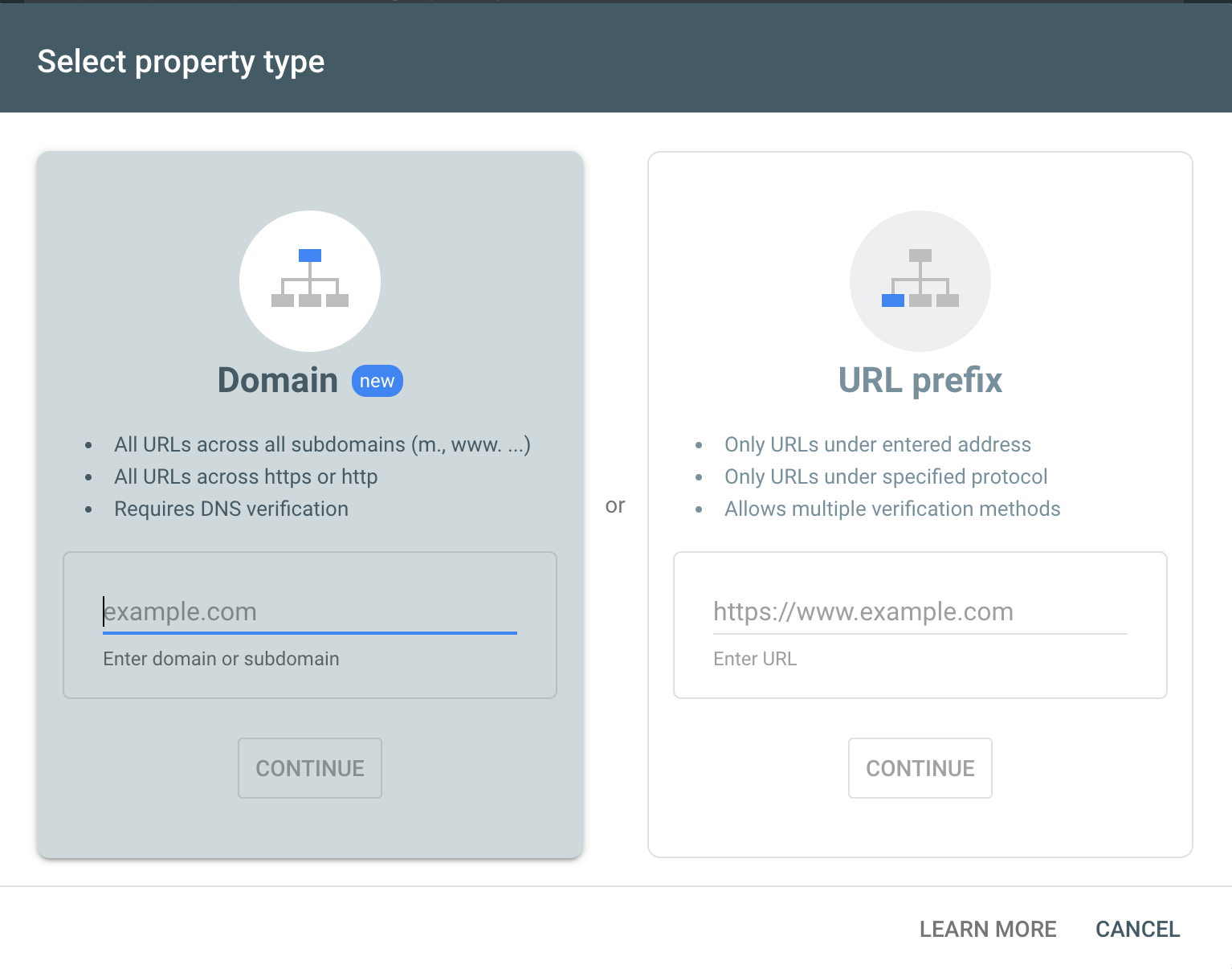
You’ll also want to set your preferred domain as your website’s ‘canon’ version. To do so, set up 301 redirects from your non-preferred domains to the preferred one.
Verifying site ownership in GSC
There are a few different ways to verify ownership of your website, including:
- HTML file. You upload a verification HTML file to a specific location on your website.
- Domain name. Log in to your domain registrar to verify your website from GSC with a DNS TXT or CNAME record.
- HTML tag. You can verify your website by adding a <meta> tag to the <HEAD> section of a web page’s HTML code.
- GA tracking code. If you have the ‘edit’ permission on GA, you can copy the tracking code that you use for your site.
- Google Tag Manager (GTM) snippet code. If you use GTM, you can copy and paste the GTM container code associated with your website. Note that you’ll need view, edit, and manage container-level permissions to perform this task.
By signing up for Google Search Console, you’ll automatically receive alerts when Google spots something that seems a little off – such as some weird markup or a page that isn’t indexed.
Once you get into the dashboard, you won’t see data right away – it could take a few days to get everything up and running (so keep this in mind if you’re working around the clock).
Adding Your Team With Search Console Users
Members of your team will likely need to have access to Google Search Console as well, and Google gives you a few different management options:
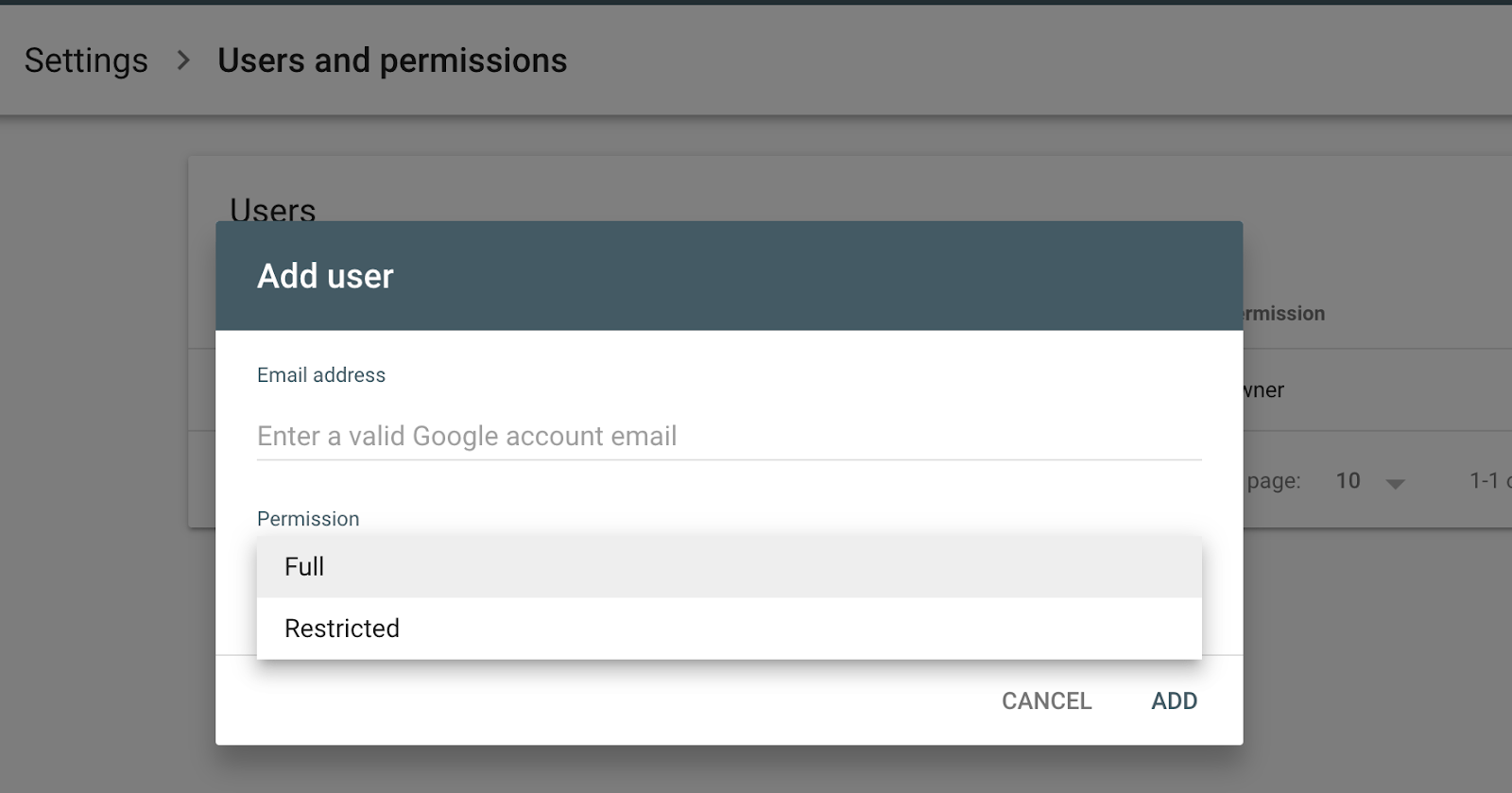
- Verified owner. The verified owner has complete control over all their properties in GSC. The owner can add and remove users, access all data, and use any tool. They’re the ‘head honcho’ that calls all the shots for the rest of the team.
- Delegated owner. There are two types of owners on GSC, verified and delegated. The verified owner can designate delegated owners – who can do just about anything except change settings. A delegated owner can also appoint other delegated owners.
- Full user. A full user can see most data and even take some actions. A typical example of a full user would be a member of your blogging team so they can analyze blog performance.
- Restricted user. A restricted user can only view data and cannot perform any actions. You can also restrict how much data they can view – such as restricting them from viewing the index coverage report.
Whoever creates the Google Search Console account for your website property will automatically be deemed the verified owner and entirely in control of the tool.
The owner can add other delegated owners and full users with view rights and some actionable power. They can also create restricted users who can only view data for the property.
Load Your Sitemap
A sitemap is a file on your website that tells Google which pages should be indexed.
According to Google, if you have a smaller site (less than 100 pages) – you can simply input the homepage URL for indexing as long as all pages are ultimately accessible from the homepage, and Googlebot will take care of the rest.

So if your website has a logical internal linking structure, uploading your sitemap to GSC may not be necessary.
You’ll only want to upload your sitemap if:
- Your site is gigantic. The larger your site is, the harder it will be for a Googlebot to crawl it without running into any issues. More pages mean more opportunities for Google to miss new changes or additions.
- Your site is brand-new. If your website is hot off the press, the chances are high that there aren’t many (or any) backlinks pointing to it. As a result, it will be more difficult for Google to discover it, so uploading your sitemap is good.
- There are orphan pages. Are there certain landing pages that don’t have any inbound links or backlinks pointing to them? If so, Google may miss them during the crawling process.
If your website checks any of these boxes, uploading your sitemap should be your next step, as it’s much better to be safe rather than sorry.
How Do I Get the Most out of Google Search Console?
Lucky for you, if you’re just starting with Google Search Console, you’re getting the best version yet.
Believe us, this tool used to be much clunkier and more difficult to understand.
That said, each website has different goals when it comes to SEO, so we’re going to break down each tab of the Console for you below.
Overview
For Search Console beginners, this is probably the most helpful section of the tool. Here, you get an overview of all your metrics and analytics. This page is excellent for glancing at your average position, CTR, and impressions.
Performance
You can configure the Performance report based on which data you’d like to view (as you would in Google Analytics). Google Search Console allows you to group and filter by queries, pages, countries, devices, search type, search appearance, and date.
Basically, this will help you view where your organic site traffic is coming from, which queries are most likely to show your page, be it click-through rates from the SERP to specific pages, how your search traffic shifts over time, any searches by device, and more.
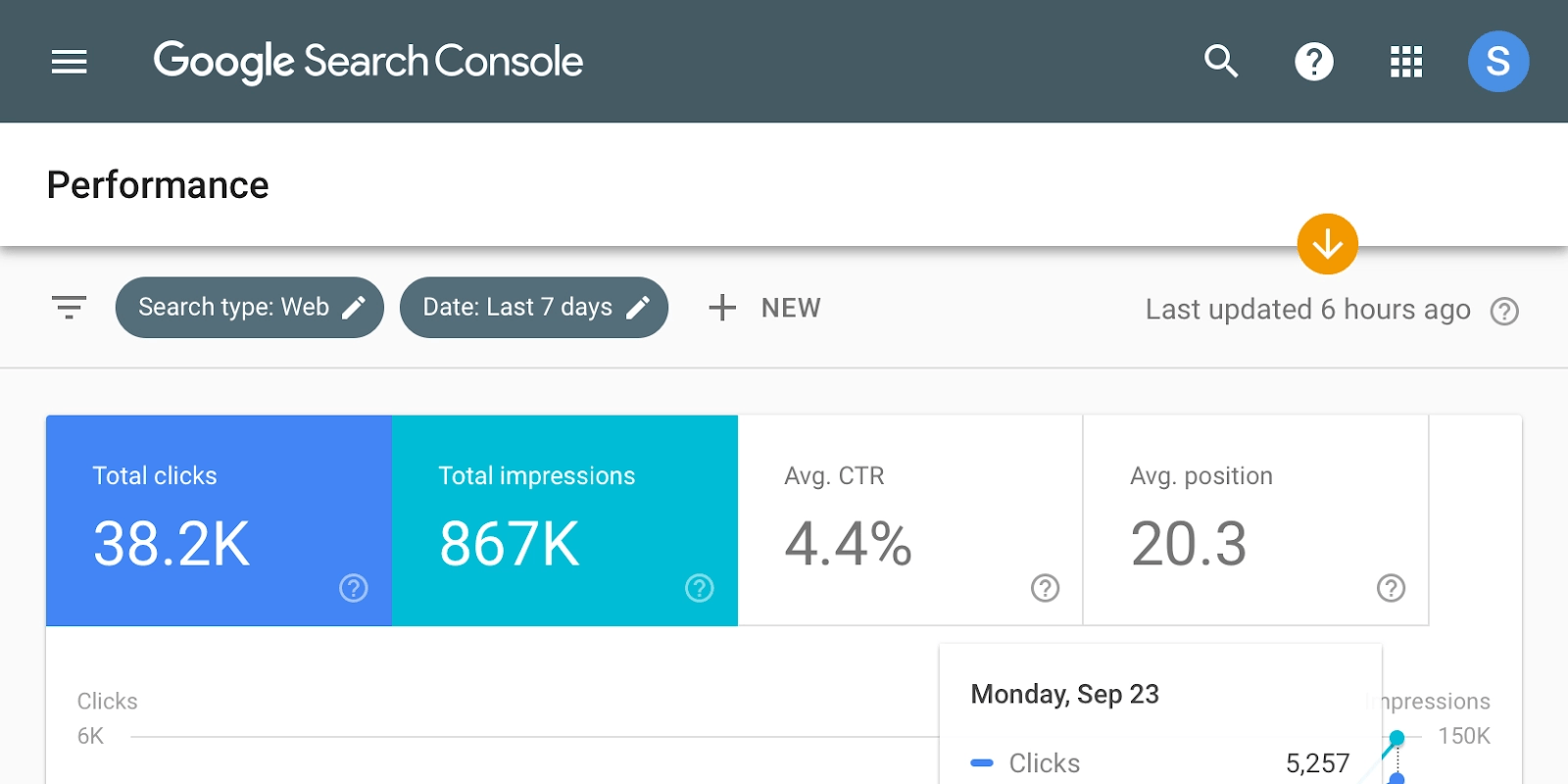
URL Inspection Tool
Put simply: input a URL from your website, and you’ll be able to access analytics for that page.
That was part of the big revamp of Google Search Console, and it’s beneficial when you’re looking to optimize specific pages for the SERP.
Index Coverage Report
Google Search Console keeps track of all the indexed pages of your website, and you can view them here.
A high-level report will display all the URLs by index status.
Statuses include Error, Warning, Exclusion, and Valid – which will be paired with a Reason for that status. While we won’t cover all the reasons here, you can reference this resource from Google on Search Console to learn more.
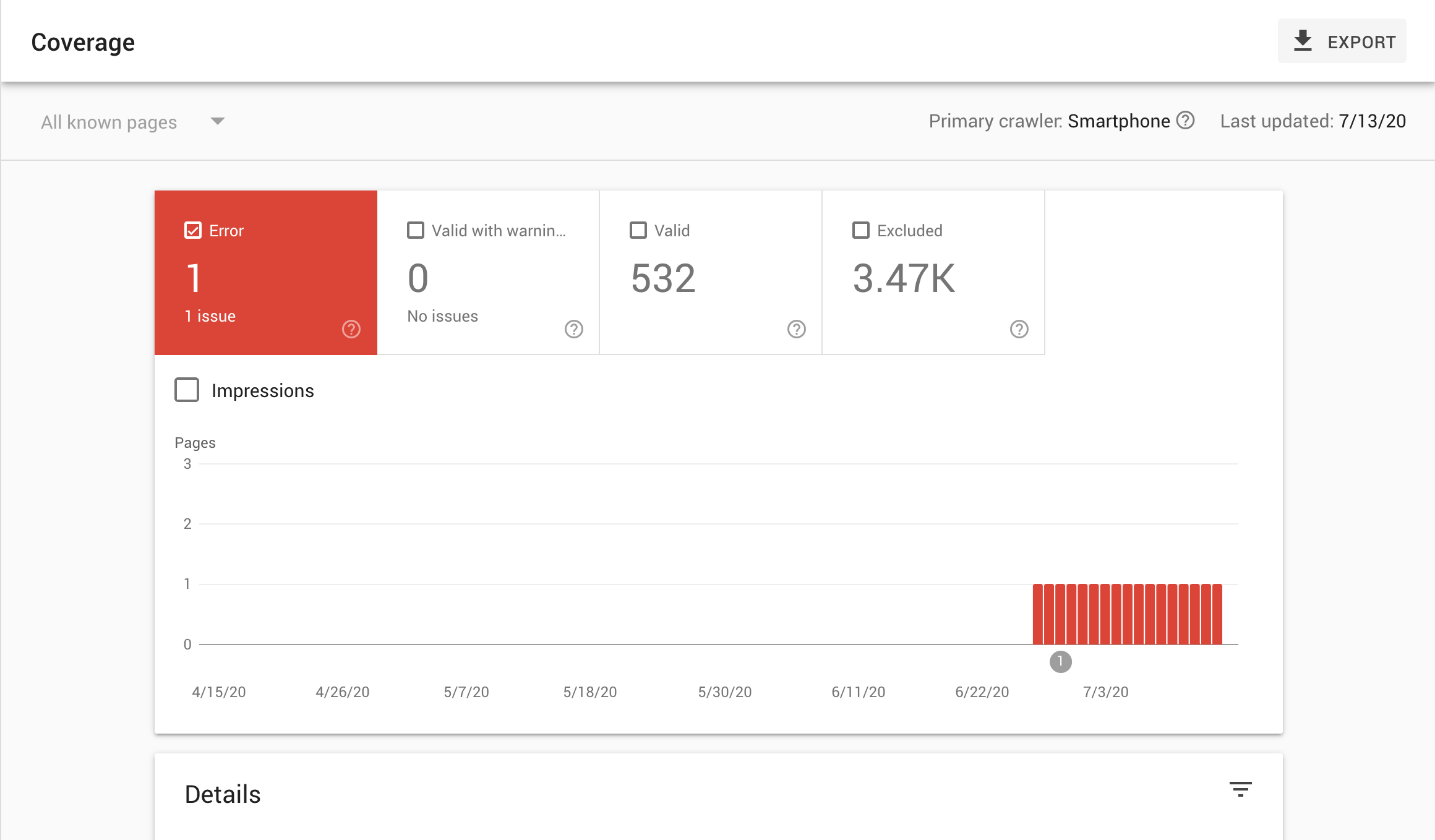
Pro tip: If your website has less than 500 pages, you may not need to use this report. Instead, you can simply search for your site on Google using this query, “site: your_site” (insert your homepage URL here), and the search results will display the pages Google knows about.
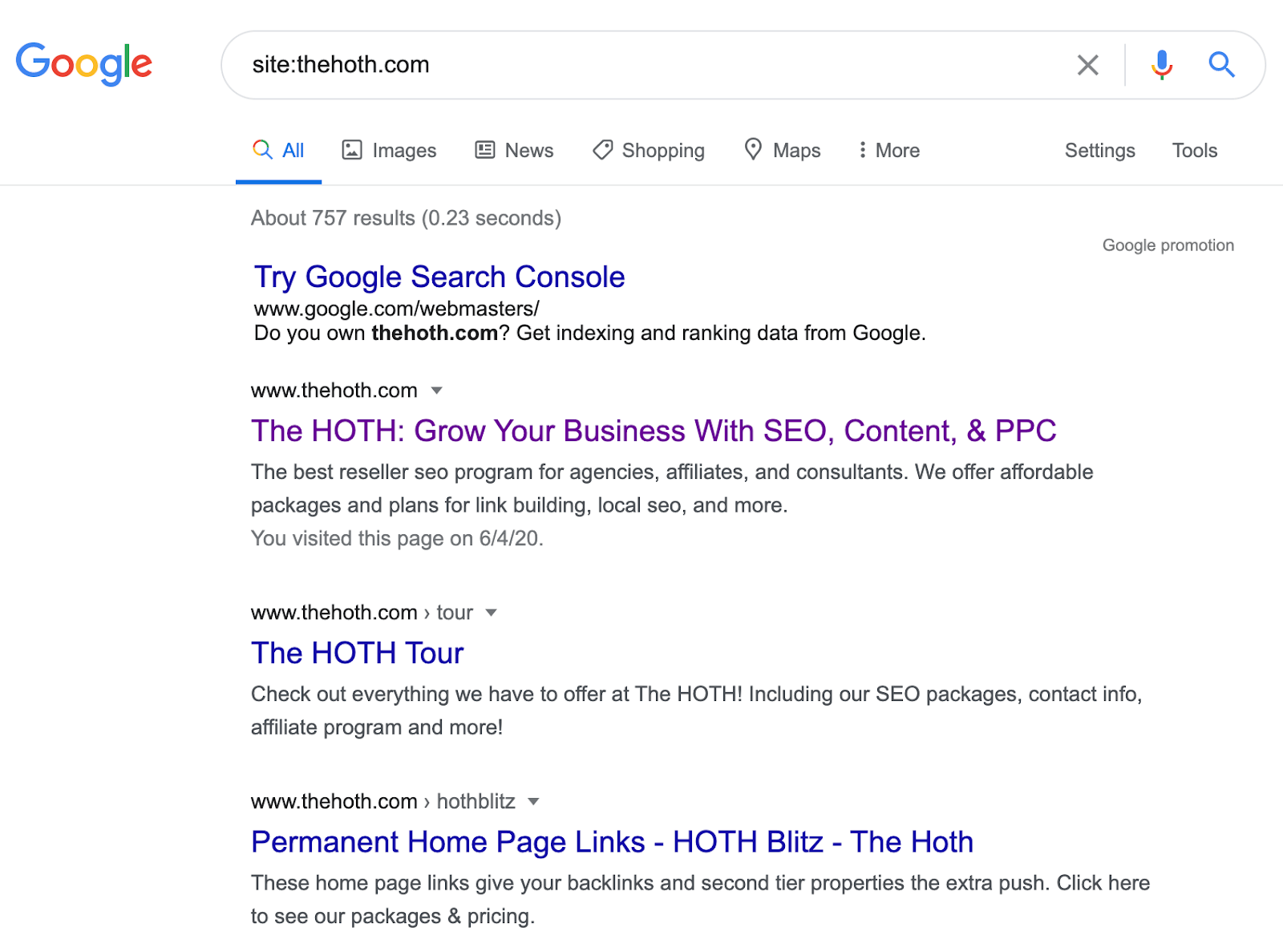
Removals
This section of Search Console will let you temporarily block your web pages from the SERP and enables you to view content on your site that Google has flagged as “adult.”
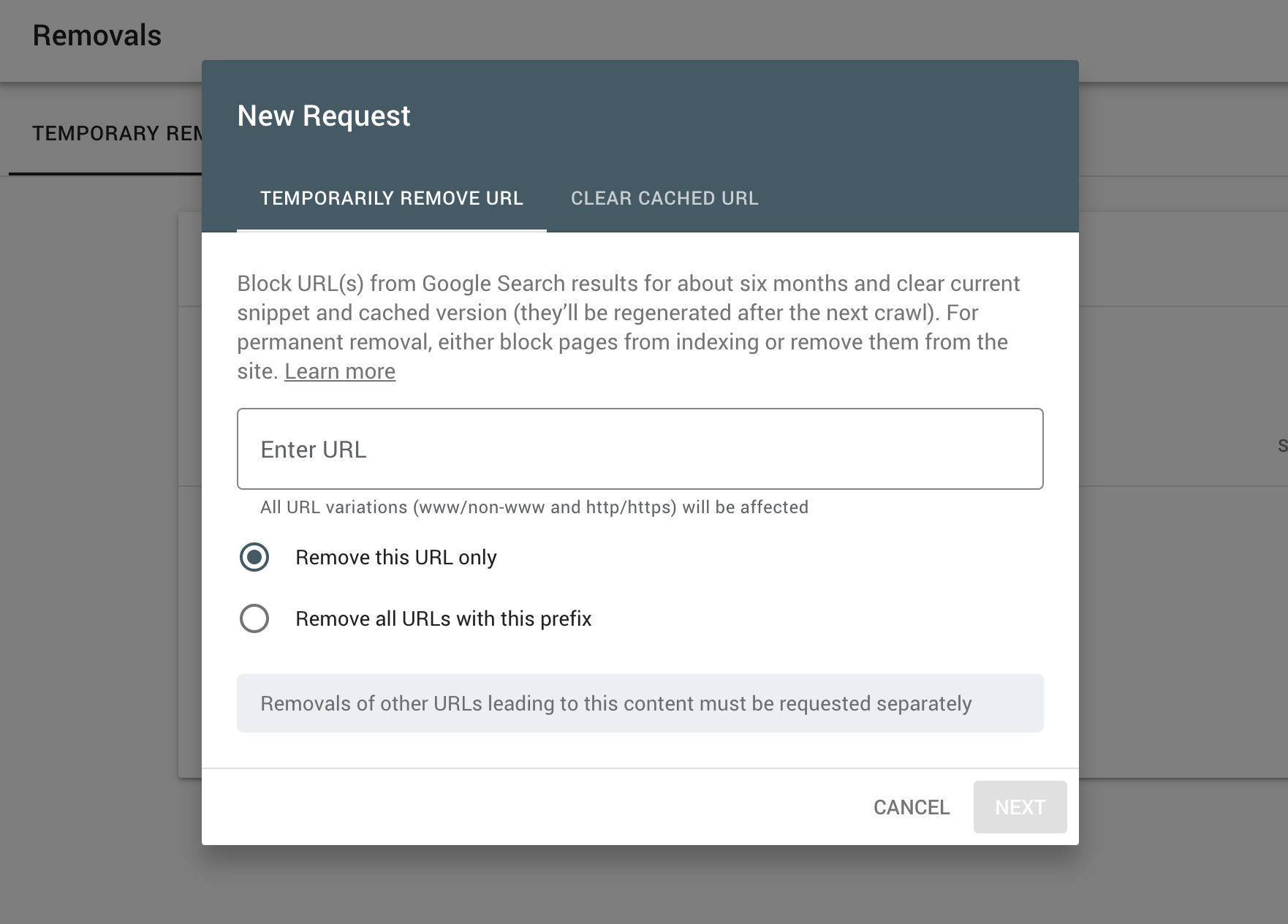
Core Web Vitals
These are an excellent addition to the Google Search Console suite that allows you to fix poor user experiences resulting from long load times, lack of interactivity, and poor stability.
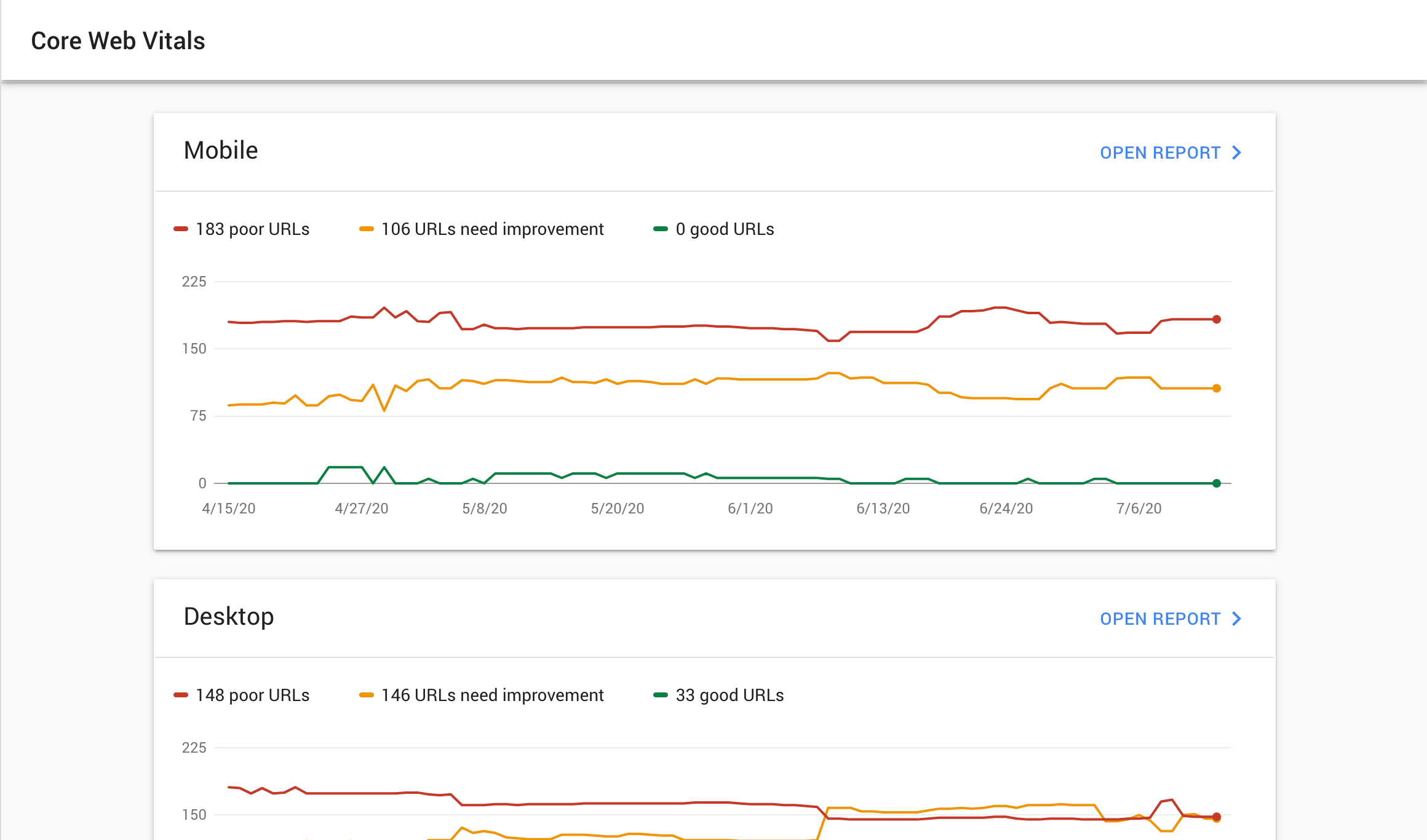
There are 3 core web vitals that Google looks at via Chrome usage data. They are the longest contentful paint (LCP), first input delay (FID), and cumulative layout shift (CLS).
LCP refers to how long it takes your page to load from when a user clicks on it. If your page has poor loading times, your user experience will suffer (so will your bounce rate).
FID is how long it takes until a user can interact with your web page. An example would be how long it takes until a user can start typing their credentials into a login page.
CLS is how stable your website is when loading its content. If it’s not stable, links and page elements will jump around during the loading process.
The core web vitals report covers each vital listed above – and ranks them as either good, needs improvement, or poor.
This report will also be broken into Mobile and Desktop so you can identify and fix platform-specific issues.
That brings us to…
Mobile Usability Report
Fairly self-explanatory, this section of Search Console will show you with pages on your site are valid, aka mobile-friendly, or rendering an error, aka not mobile-friendly.
Now that there’s mobile-first indexing, you’ll want to pay close attention to this report.
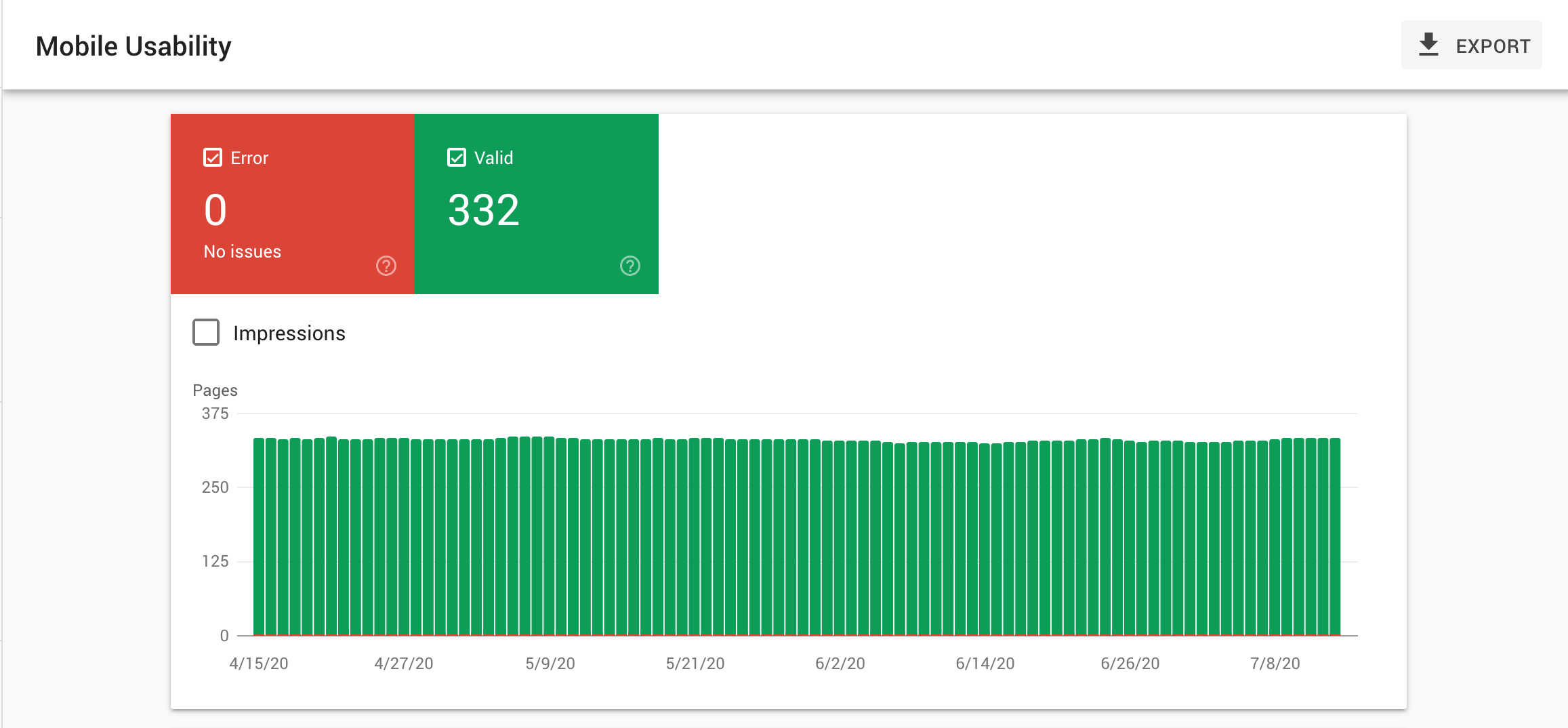
When you’re looking to fix mobile rendering issues, Google recommends fixing them in the order they appear on the summary report page–it’ll be sorted from general issues (like templates) to more granular.
When you’ve completed fixing the errors, you can “Validate and Update Google” from here to improve your ranking.
For more details on any errors that you may encounter, check out this resource from Google.
Links
This report will give you even more insight into your top-linked pages, which domains link to you, and supplement the data you get through Google Analytics.
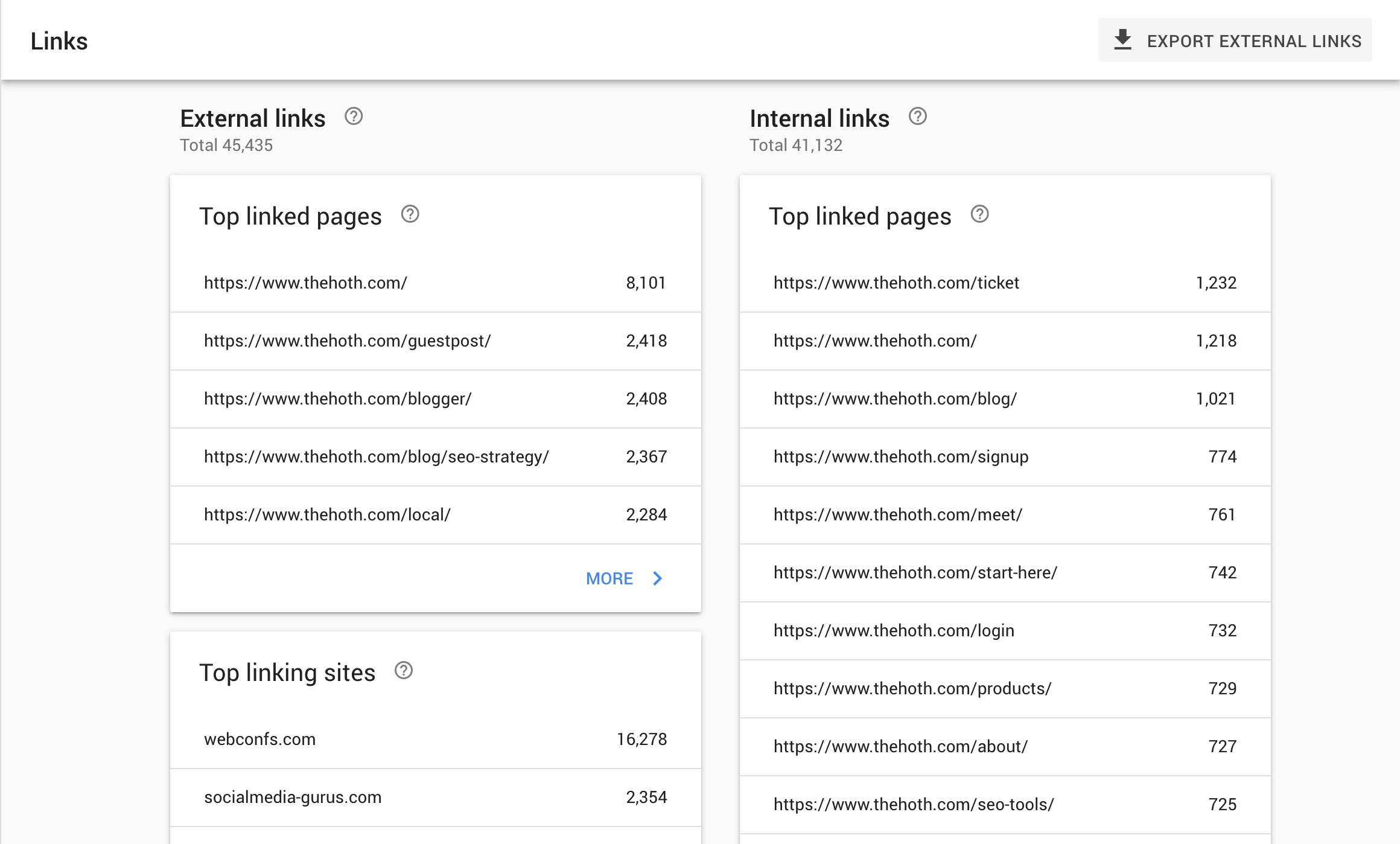
One of the best features here is the “top linked text,” which gives you insight into the domain linking to you and the actual text that the writer hyperlinked to your page. That is a great way to know how others value the content you are producing.
Legacy Tools and Reports
If you’re a legacy user of Google Webmaster Tools, you may be missing out on the old set-up (with way more options on the left side).
Because some of the tools that were eliminated don’t yet have replacements, Google stuck them under “Legacy Tools and Reports” for you to access.
- Crawl stats: if you’re brand new to Search Console, you probably won’t need this. Crawl stats checked the number of times Google crawled your site and how many requests it made. Developers or SEOs mostly used this. However, check this every so often to make sure Google isn’t sending too many requests to crawl your site!
- Crawl Rate Settings: use this to reduce the number of times Google crawls your site, mainly if your crawl stats show too many requests.
- Tester for robots.txt: this helped developers troubleshoot their robots.txt files and fix blocked pages on your site.
- URL parameters tools: this was a pretty niche tool for pages with parameters that changed the content of the page, e.g., for international retailers. It was tricky to use anyway, but advanced SEOs probably still use it.
- International Targeting: This was useful for international websites that feature different languages when adding hreflang tags or a primary country on your website.
- Google Analytics Association: this is a pretty big one that I still use. It imports Search Console data into Google Analytics and approves/denies other association requests from Youtube, an Android app, etc.
Google Search Console also allows you to verify and edit issues such as schema markup and errors with structured data.
Connecting Search Console to Google Analytics
To leverage data from Search Console in Google Analytics, you’ll need to authorize data sharing in your GA settings.
Go to admin, click the property you want to add, go to the Search Console setting, select the data you wish to view, and hit save.
One final note: Search Console now keeps data for 16 months, so that is the max time you’ll be able to access through GA. There is an average lag time of 48 hours before data will be shown in GA or Search Console.
Concluding Thoughts: What is Google Search Console?
By following this guide, you’ll be able to make sure you’re getting the most out of this powerful, free tool.
Take the time to correctly set up your Google Search Console and unlock truckloads of free data, including mobile usability reports, site authority, backlinks, and several other SEO metrics.
We know it can be a little overwhelming trying to decipher the data – but there’s no reason not to use Google Search Console for a small business.
If you’d like some help, you can schedule a free SEO consultation with us. We’d be happy to lend a hand and help identify some quick wins for you.



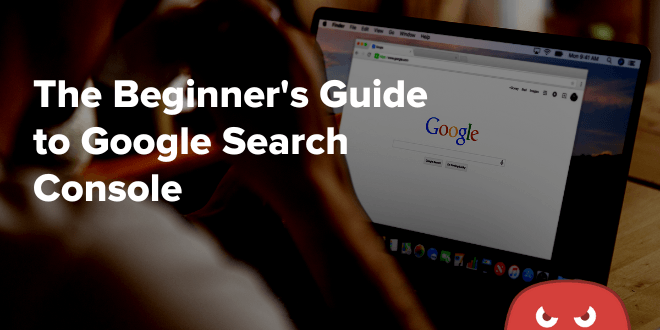





Great post very informative and helpful for me about Google Search Console.
Thank you so much for sharing…
one of the best information you shared with us.